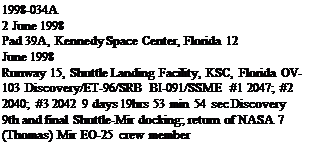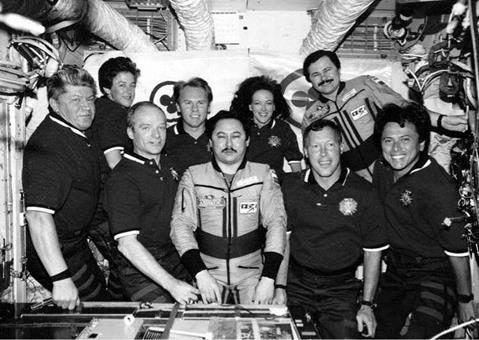STS-90
|
Int. Designation |
1998-022A |
|
Launched |
17 April 1998 |
|
Launch Site |
Pad 39B, Kennedy Space Center, Florida |
|
Landed |
3 May 1998 |
|
Landing Site |
Runway 33, Shuttle Fanding Facility, KSC, Florida |
|
Launch Vehicle |
OV-102 Columbia/ET-91/SRB BI-091/SSME #1 2041; |
|
#2 2032; #3 2012 |
|
|
Duration |
15 days 21 hrs 49 min 59 sec |
|
Call sign |
Columbia |
|
Objective |
Neurolab |
Flight Crew
SEARFOSS, Richard Alan, 41, USAF, commander, 3rd mission Previous missions: STS-58 (1993); STS-76 (1996)
AFTMAN, Scott Douglas, 38, USN, pilot
FINNEHAN, Richard Michael, 41, civilian, mission specialist 1, payload commander, 2nd mission Previous mission: STS-78 (1996)
HIRE, Kathryn Patricia, 38, USN, mission specialist 2 WIFFIAMS, Dafydd Rhys, civilian, Canadian, mission specialist 3 BUCKFEY Jr., Jay Clark, 41, civilian, payload specialist 1 PAWEFCZYK, James Anthony, 37, civilian, payload specialist 2
Flight Log
The launch of Neurolab was delayed by 24 hours from 16 April due to problems with one of the two network processors aboard Columbia. These format data and voice communications between the Shuttle and the ground and the unit had to be replaced. The payload for this mission was the final flight of the Spacelab Fong Module, which had first flown in 1983. The science programme it contained was designated Neurolab, and included 26 experiments grouped together to form one of the most extensive investigations into the most complex and least understood part of the human body – the nervous system. The primary objective of this research was to expand our understanding of how the nervous system develops and functions in microgravity and for such a comprehensive research programme, the test subjects included more than just the seven astronauts. Making the journey with the human crew were rats, mice, crickets, snails and two species of fish.
This mission had its origins in 1991, when NASA proposed a mission to contribute to the “Decade of the Brain”. A total of 132 experiment proposals were reduced to 32, with 26 flying on STS-90 and the remaining six reassigned to later
|
|
As American residency on Mir draws to a close, so too does another aspect of the Shuttle programme – Spacelab. On 12 February 1998, the Neurolab payload in the Spacelab Long Module is lowered into the cargo bay of Columbia in OPF Bay 1 at KSC. This was the final flight of the European-built Spacelab module system, first flown as Spacelab 1 in November 1983. There had been 16 Spacelab Long Module missions between 1983 and 1998 missions. The research programme covered eight areas. Adult neuronal plasticity studied the ability of neurons to react to different conditions (in this case microgravity) to make new connections in new ways, allowing the neurosystem to compensate for the new environment. This programme used rats as the test subjects. Mammalian development research utilised the rats and mice to answer key questions such as “Can walking be learned without gravity?” Aquatic experiments studied the effects of microgravity on otoliths and statolith development and adaptation in oyster toadfish, swordtail fish and freshwater snails. Neurology research on crickets was used to help understand how much normal development is pre-programmed in the genes and how much requires clues from the environment. The remaining studies, which were carried out by the human crew, included investigations into the autonomic nervous system, sleep, vestibular experiments and sensory, motor and performance studies.
Neurolab was activated 1 hour 45 minutes into the mission. The crew followed a single-shift system, with the science crew participating in or activating most of the experiments while the orbiter crew looked after the spacecraft and its systems. The orbiter crew (commander, pilot and MS2/flight engineer) assisted the science crew as required throughout the mission. This was an international, mission with cooperation between NASA and the space agencies of Canada (CSA), France (CNES) and Germany (DARA) as well as the European Space agency (ESA) and the National Development Agency of Japan (NASDA). Most of the research was conducted as planned, except for the mammalian development studies, which were prioritised due to the unexpectedly high mortality rate of the neo-natal rats aboard (55 of the 96 nine – day-old rodents died).
A week into the mission, the crew worked with engineers on the ground to overcome a problem with a system valve in the Regenerative Carbon Dioxide Removal System, which threatened to cut short the flight. A decision to extend the mission was considered, but when the science community indicated that this was not necessary, and with weather conditions expected to deteriorate after the scheduled 3 May landing, the mission was ended as planned after 16 days. It was the end of a highly successful mission, but also of the Spacelab Long Module series.
Milestones
206th manned space flight 120th US manned space flight 90th Shuttle mission 25th flight of Columbia
16th and final flight of Spacelab Long Module 13th and final EDO mission

 |
Flight Crew
PRECOURT, Charles Joseph, 43, USAF, commander, 4th mission Previous missions: STS-55 (1993); STS-71 (1995); STS-84 (1997)
GORIE, Dominic Lee Pudwill, 41, USN, pilot CHANG-DIAZ, Franklin Ramon de Los Angeles, 48, civilian, mission specialist 1, 6th mission
Previous missions: STS 61-C (1986); STS-34 (1989); STS-46 (1992); STS-60 (1994); STS-75 (1996)
LAWRENCE, Wendy Barrien, 38, mission specialist 2, 3rd mission Previous missions: STS-67 (1995); STS-86 (1997)
KAVANDI, Janet Lynn, mission specialist 3
RYUMIN, Valery Viktorovich, 58, civilian, Russian, mission specialist 4, 4th mission
Previous missions: Soyuz 25 (1977); Soyuz 32 (1979); Soyuz 35 (1980) NASA 7 Mir EO-25 resident down only:
THOMAS, Andrew Sydney Withiel, 46, civilian, mission specialist 5,
Mir EO-25 cosmonaut researcher, NASA board engineer 7, 2nd mission Previous mission: STS-77 (1996)
Flight Log
Apart from a slight delay in tanking operations, the launch of the final Shuttle mission to Mir proceeded nominally. This was the first docking mission for Discovery, which successfully joined the space station on 4 June. The hatches were opened on the same day and Thomas transferred to the Shuttle crew, ending 130 days of residency on Mir. Prior to his residency, Thomas had been criticised by the Russians for his limited ability to speak the language, but with Russian being the only language spoken on
|
End of an era. The STS-91 crew and the Mir EO-25 crew pose for the final traditional in-flight NASA Shuttle-Mir crew photo in the core module of the station. L to r Ryumin, Lawrence, Precourt, Thomas, Musabayev, Kavandi, Gorie, Budarin, Chang-Diaz |
Mir, he soon became well versed. With the transfer of Thomas to the Discovery crew, a total of 907 days had been logged by the seven resident astronauts aboard Mir. In addition, there had been a US presence in space for 812 consecutive days and on Mir for 802 consecutive days.
During the four days of joint operations, the crews transferred 500 kg of water and a further 2,130 kg of experiments and supplies. US long-term experiments were also moved back into Discovery or the SpaceHab module from the station. The Shuttle crew completed a range of secondary experiments during docked activities. Although he was part of the Shuttle crew, cosmonaut Valery Ryumin, who had spent about a year aboard the Salyut 6 station on two six-month missions in 1979 and 1980, was aboard to evaluate the state of the station and, according to NASA, to confirm the station’s condition for mothballing and decommissioning. Instead, he indicated that it was still viable for future operations. One of the less publicised “experiments’’ was the transfer of a stowed American EMU through the smaller opening of the Orbiter Docking System (ODS), a process which would become a regular operation on ISS. The EMU are normally bundled in a Lower Torso Assembly Restraint Bag (LTARB) for ease of handling, but during ground tests, it was found that it took less time to simply stow the gear and clear a path through loose equipment around the connecting hatches. With no high-fidelity mock-ups on Earth, it was useful to try this method aboard an actual station in space. The information gained would be valuable in planning such transfers on ISS.
After the joint programme had been completed the hatches were sealed and the spacecraft separated on 8 June, marking the final Shuttle docking mission and the conclusion of Phase 1 of the ISS programme. It was now time to move toward the assembly missions for ISS later in the year.
Over the preceding six years, considerable hurdles had been overcome, differences ironed out and a strong partnership formed. This resulted in ten missions and nine dockings to the Mir complex, the residence of seven astronauts on Mir and training for five cosmonauts to fly on the Shuttle. The difficulties, and at times dangers, of long – duration flight were quickly learned by the Americans – something the Russians had been aware of for years. For the Russians, their learning curve was in accepting an international cooperative partner beyond the former Soviet Bloc countries and friendship agreements. The Shuttle (and American money) gave the aging Mir station a prolonged life and Mir gave NASA the experience in space station operations it badly needed before committing to ISS operations. Lessons had been learned the hard way at times, but they were essential lessons. Without Shuttle-Mir, the ISS programme would have been much harder to initiate.
Milestones
207th manned space flight
121st US manned space flight
91st Shuttle mission
24th flight of Discovery
9th and final Shuttle-Mir docking mission
11th SpaceHab mission (6th single module)
1st docking mission for Discovery
1st user of super-lightweight ET
Completion of ISS Phase 1 programme












